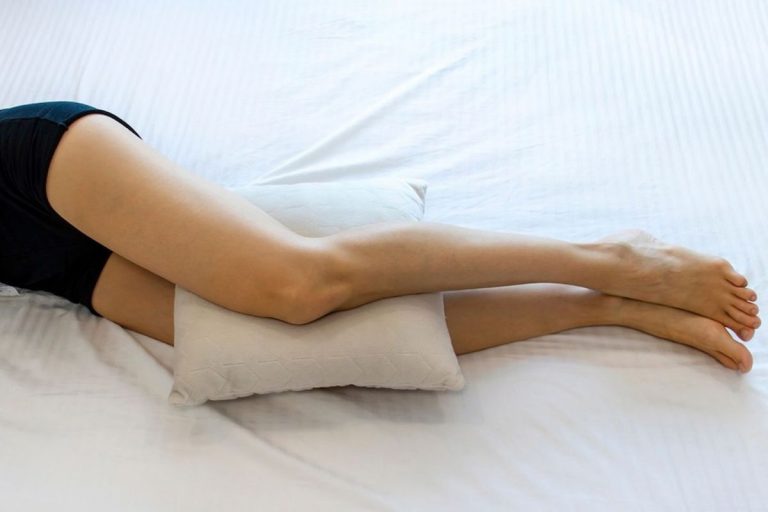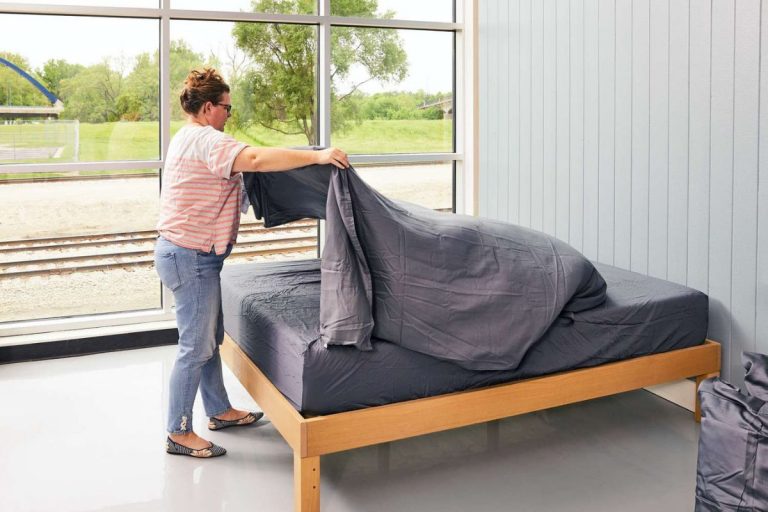Whether you want to believe it or not, air mattresses have been around more than most mattresses used today. They go back to the 19th century and are still used today. You can find them in hospitals, as additional beds in houses, and even in some hotels. However, the quality of sleep on air mattresses has always been up for debate, are air mattresses bad for your back and overall quality of sleep?
Many people have split opinions on air mattresses. While some sleep experts discourage consumers from buying air mattresses unless it’s an utmost necessity, many others say that air mattresses are not what they used to be and that improvements in their chamber technologies, pumps, and other features make air mattresses ideal for backup beds, as well as a regular bed for those who are restricted on bedroom space and need to use a bed that they can deflate and put away during the day.
Needless to say, air mattresses are affordable, have a wide range of applications, and are used by many people who can’t afford latex or innerspring mattresses. However, certain models may not be the most comfortable to sleep in and can cause various inconveniences to people who want to sleep on them.
Some people that tried these mattresses decades ago were discouraged because they’d either sag too quickly, deflate, or generally cause back pain which would disrupt their sleep. However, what to do when an air mattress is the only option there is? Are they better than they used to be?
In this article, we’ll talk about sleeping on air mattresses when having back problems. We’ll detail whether air mattresses can worsen your back pain, or cause it if there wasn’t one. Additionally, we’ll look into some improvements that were made to air mattresses over the last few decades.
Are Air Mattresses Bad for Your Back?
At some point in life, everyone tried to sleep on an air mattress. Whether that was just for the afternoon nap on the beach or a resort, or a few night’s sleepovers, or a camping adventure, it doesn’t matter.
The impressions over the first few nights of sleeping on them are usually positive, but most people don’t make it their regular habit to sleep on an airbed because it’s not the most convenient option compared to regular mattresses that we see on the market.
Something that a lot of air mattresses had problems with was the use of horizontal chambers instead of vertical ones which offer more support and give a feeling as if you are sleeping on a medium to firm hybrid or innerspring mattress for more support.
Now air mattresses are more sophisticated, come with features like auto inflation, vertical air tubes, and chambers, and have a more sophisticated construction that gives the impression of sleeping on a real mattress made with latex or memory foam.
Air mattresses are accompanied by a different combination of materials including plastic and polyester variations, along with vinyl and rubber for more support and balance. The adjustable combination of chambers means that the user can easily inflate the mattress to be either softer or firmer.
Many people gave shots to air mattresses when they first debuted in the market. A lot of consumers found the idea of saving space and being able to take their airbed to camp or a trip attractive so they were quick to invest in a new mattress.
However, problems with airbeds started when they attempted to sleep for more than a few nights but regularly, and when the mattress first started deflating and not holding as much air as it was supposed to.
The initial mattresses would deflate too fast and they were too soft even when they were fully inflated which led to back problems in those who already had the mild problems, as well as heavier sleepers that would sink in entirety. Sleeping on the side was relatively comfortable but not in the long term.
As the years passed some of these problems were tackled but not all of them. Some pricier models would have more complex air chambers and firmer sleeping surfaces, but still, yet, these air mattresses were less suitable for sleeping in the long term, but still okay for camping and sleepovers.
However, today, these beds are much more advanced. Some companies are making sophisticated air beds with multiple layers of vertical and horizontal bed chambers, with smart features and automatic inflation and deflation. They are so improved that even some 5-star hotels and hospitals use them.
Sleepers can easily adjust the firmness level of their bed and change it in case they want to sleep on the other side or change their preferences over time. While there are still some more affordable models that come with horizontal chambers and manual and electric pumps, most of them have built-in pumps that inflate and deflate automatically.
For people who are suffering from back pain, searching for more supportive and rigid options with adjustable levels of firmness has always shown to be more fruitful and ultimately led to improvements in back pain, according to scientists.
One of the minor problems that come with these mattresses now however that the built-in pumps sometimes die and the mattresses are out of their warranty and can’t provide the help to replace the pump. Nevertheless, some companies now ship with two pumps.
Overall, air mattresses were improved with great detail, especially for people who are restricted on budget and space and those who suffer from lower or upper back pain. Still, there are some exceptions.
Also Read:
Problems With Air Mattresses And Back Pain
As mentioned before, while air mattresses majorly improved over the last couple of years and decades, there are still a few dealbreakers that don’t make them the most dominant type of mattress for home use.
- Horizontal Chambers – There are still a lot of cheaper options that offer horizontal chambers for sleep. Those are bad because they don’t give enough support to slightly heavier people and those suffering from lower back pain. In addition to that, they can make you collapse on the mattress and possibly roll-off due to poor edge support.
- The cheaper mattress is usually of a poorer quality – If you count on an airbed just for trips and guest sleepovers, they won’t cause any back pain and are likely going to feel cozy and comfortable if you sleep on them for a couple of nights. But, the risk of rupturing and inflation is higher in the long-term use if you plan to get a cheaper mattress.
- Not recommended for pregnant women – While sleep experts actively argue about whether women should sleep on an air mattress in the long term because of adjustable firmness levels and other features, the pain women experience and the comfort they need is higher than airbeds can offer.
- Not recommended for extremely heavy sleepers – Sleeping on a soft mattress can be difficult for people who suffer from obesity and would need multiple air chambers that can carry their weight. Rupturing and constant deflation can be annoying even though many air mattresses come with a weight limit that is usually measured for two people using the mattress.
- Back Alignment – If your air mattress doesn’t have automatic inflation and firmness adjusting, it’s pointless. It’s important to always be able to adjust the firmness of your mattress and hone it to your needs and what will make your back pain relieved. The problem is getting bigger when two people sleeping on air mattresses need different firmness levels for optimal comfort.
6 Tips For Reducing Back Pain While Sleeping On Air Mattress
We saw the great improvement air mattresses can offer now compared to 20 years ago. However, is that enough to make someone stick to them for several years before picking a new one? Not going for the cheaper options is always recommended if you want to keep your mattress for a few years, but what else can you do? Read on!
1. Turn It Into A Real Bed
When we say “turn it into a real bed” we don’t mean get sheets, pillows, blankets, and comforters, because it’s already expected that you use these to make your bed comfortable. What we actually mean is to give it as much support as possible.
First things first, avoid putting your mattress on a carpet or a soft surface. Moreover, don’t put it on top of another mattress because that way, you won’t get the support you are expecting to get. Instead, there are other things that you can do.
Put your air mattress inside of a bed frame if you can afford to get it in your bedroom. Understandably so, if your bedroom is too small, you won’t be able to fit the frame in. Instead, there are adjustable slat sets that you can get, which can give enough support.
When the day comes and you want to remove your mattress, all you have to do is remove slats too. Alternatively, some companies sell foldable bed frames, so if you have enough space to fold a bed frame and the mattress, this is the option you should definitely go for.
Editor’s notes: There are many affordable bed slat sets that you can get online, especially on Amazon. Our favorite ones include Ashley’s and Mayton‘s. Amazon Basics also sells amazing foldable bed frames.
2. Use a Mattress Topper
If you feel like the bed mattress is too hard and too firm, and you can’t find a way to make it softer by adjusting the firmness of the mattress, one of the options is to get a mattress topper. It’s also a good idea to use a mattress topper if you need more conforming support than the memory foam offers.
There are different options when it comes to mattress toppers, some of them are made more like mattress pads and are made out of cotton, wool, or some down or down alternative material. Those thicker and more therapeutic and supportive toppers are made of memory foam and latex mostly.
The more support you need the more thickness you’ll need. While some mattress toppers have as little as 2-inches of support, some other options are 4-4.5-inches thick and mix multiple types of memory foam for better comfort.
Editor’s notes: Be mindful of the weight limit of your mattress when you’re getting a mattress topper. Also, since air mattresses can trap a lot of heat, you should go for a topper that has a good temperature regulation, such as gel memory foam options.
3. Inflate Regularly
Some air mattresses come with manual or electric pumps for inflation and deflation. That being said, they probably don’t have the option to automatically detect deflation and then inflate it back to the original state. If you don’t have that option over time you might notice that your mattress doesn’t feel as firm and supportive as it used to.
The best practice includes inflating regularly and checking the mattress surface for potential ruptures or anything that makes your mattress lose air. You should inflate it every couple of days and check if it needs inflating.
Editor’s notes: If you don’t notice that your mattress is being deflated, you should still check it so that you don’t lose sleep quality without realizing that your mattress is leaking air. Checking regularly and maintaining your mattress firmness won’t result in back pain.
4. Go for Vertical Air Chambers
Whether you are going camping or just expecting guests and family relatives who will sleepover, you want to ensure the best possible quality with your air mattress. Horizontal air tubes and chambers are being replaced by vertical ones because they offer more balance and support.
Sustaining more air upward also means that the mattress can hold your weight and distribute the pressure points evenly. Usually, pricier models come with vertical chambers, which are good for your back and are less likely to give you pain.
Editor’s notes: Another good thing about vertical air tubes is that it gives the feeling of sleeping on the mattress instead inside of it. Typically, it works similarly to pocketed innerspring in mattresses that offer more balance to your back pain, which is great for back and stomach sleepers. Additionally, they offer edge support so you won’t fall off your bed.
5. Adjust Inflation Levels to Your Sleep Position
Not all inflation levels are good for your particular sleep position. Sleeping on the side requires you to have a bit softer mattress and a bit more of a “cradling” sensation which is something that air mattresses don’t always give.
For stomach sleepers, firmer levels are always better, because the sleeper won’t sink and the spinal alignment will be achieved. It becomes difficult when you sleep with a partner who has different sleep preferences. Still, some pricier and more premium models offer separate air chambers for each side, which is good for those who sleep on different sides.
Editor’s notes: If you’re a side sleeper and the mattress simply feels too firm and gives you back and hip pain, a mattress topper and wedgie pillows are the best solutions.
6. Store Carefully
If you don’t usually resort to the air mattress, you want to make sure to store it properly so that it’d last the longest possible, and wouldn’t rupture and give you unwanted results.
Airbeds usually come with convenient bags that allow you to fold them once it’s deflated and store them away until the next camping adventure, or any other time you may need them. Of course, if you go for medically-approved luxurious air beds, that’s not the case, as they also come with their bed frames.
Editor’s notes: Make sure to get a mattress that either comes with patches for repairing a rupture, or a long and lasting warranty plan which allows you to replace it for some other model in case things with your current air mattress don’t go as planned.





